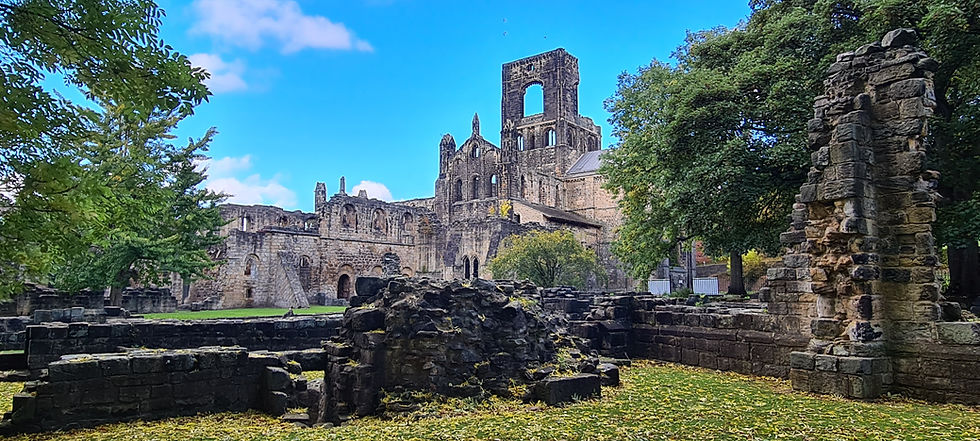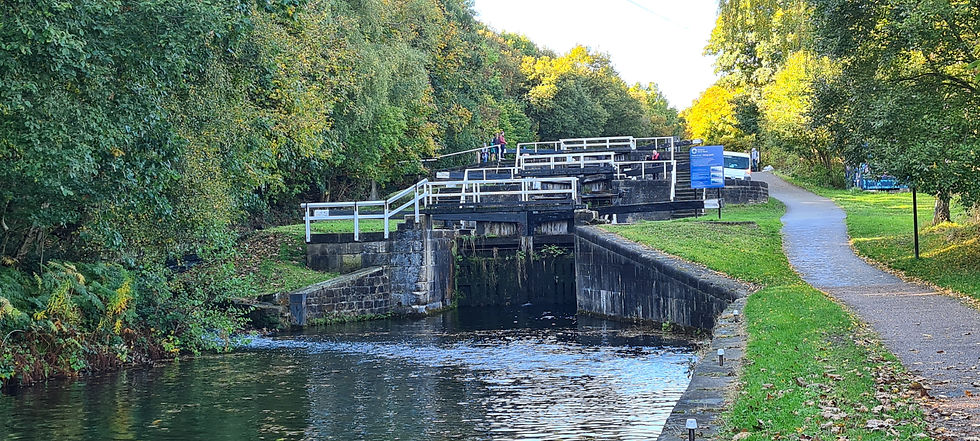Kirkstall Trail
- Paul Clarke
- Jul 19, 2023
- 5 min read
The Leeds-Bradford line splits into two as it runs between the two cities for which it is named; we first take the northernmost branch to visit Kirkstall. Kirkstall is a suburb of leads which grew up around the twelfth-century Kirkstall Abbey and the nearby Kirkstall Forge, which was established in the same century on the mill race of a corn mill owned by the monks. Kirkstall Forge was a working forge from c.1151 to 1995, making it one of the oldest most continuously used industrial sites in England; it is now being redeveloped as a mixed commercial and housing development. The name Kirkstall is derived from the Old English words “kirk” meaning church and “stall” meaning place, and thus means “place of a church”.
The original Kirkstall Forge Railway Station opened in 1860 and closed in 1905; the present station opened in 2016 to serve the new Kirkstall Forge development and is located near the site of the original. It is thus the newest station on the West Yorkshire Metro network, at least until White Rose opens. Leave station via the exit on Platform One and turn left along Butler’s Wharf, which turns right and crosses the River Aire then turns left and right again to end at Abbey Road. Cross straight over the road and walk straight ahead along a path into Hawksworth Wood, then immediately turn right and follow a path running parallel with Abbey Road, which the path eventually joins.
Continue to follow Abbey Road, crossing over and looking out for the Kirkstall Forge Milestone on the right hand side of the road, another one of those quirky architectural curiosities that we keep encountering on these walks. This Grade II-listed obelisk was built in 1829 and declares that both London and “Edinburg” are 200 miles away. After passing the Obelisk, cross the entrance to a drive leading to the Kirkstall Forge development (the historic forge site is, alas, inaccessible), then immediately turn right and then left along a path through Forge Wood. Follow this parallel with the road until it reaches a car park behind Burley Rugby Union Clubhouse. Leave the car park then turn right and follow a path between a wall running alongside Abbey Road on the left (the Vesper Gate public house can be seen on the opposite side of the road) and the rugby pitch on the right. At the end of the pitch, continue straight ahead past Kirkstall Abbey Tennis Club to enter the grounds of Kirkstall Abbey.

Kirkstall Abbey
This is perhaps the high point of this particular walk, a ruined but still impressive Cistercian abbey founded c.1152 and disestablished during the Dissolution of the Monasteries under Henry VIII; the ruins were acquired by the Leeds Corporation in the late nineteenth century and the abbey is now a Grade I-listed building and a Scheduled Ancient Monument. The abbey ruins are open to visitors for a fee; the grounds form a popular riverside park.
Take a detour to the left across Abbey Road to visit Abbey House Museum, which is the former Abbey gatehouse. Otherwise, continue towards the abbey, then walk anticlockwise around it, passing the visitor centre, and on the other side bear right towards the river, passing an historic weir, sluice gate and keeper’s cottage to follow a path alongside a mill race (crossing a footbridge over it at one point) and eventually reaching Bridge Road. Directly opposite, the former Star and Garter can be seen, whilst to the right is Kirkstall War Memorial. Turn left and walk to a junction, looking out for the “Drink and Be Grateful” water fountain (which dates from the nineteenth century but has been re-located from its original position) on the left. Turn left past the fountain and follow Abbey Road past Kirkstall (South side) Abbey Mills on the left and the West End House public house on the right.
Turn right along Norman Street and at the end turn right along Morris Lane. Turn left along Park Mount, passing the Church of St. Stephen on the right; this Grade II-listed church dates from 1828-1829. Continue along Park Mount, which turns right and becomes Vicarage Way. Turn right again along Vicarage View, then right along Station Parade to return to Morris Lane. Turn left and on reaching a crossroads continue straight ahead then bear left to follow a path through Kirkstall Hill Wood to Kirkstall Hill. Turn sharp right and cross over, then bear left along a footpath past Sandford Playground to reach Sandford Road.
Turn right and walk to Beecroft Street, passing the Sandford Road County Primary School on the right, then turn left and follow the street to Commercial Road. Turn left along Savins Mill Way and follow this to Bridge Road, then turn left, passing Kirkstall (North side) Bridge Mills and Kirkstall Bridge Inn, before crossing Kirkstall Bridge over the River Aire. On reaching a fork, bear left along Wyther Lane, then cross over at the next junction and follow a path through trees to reach the towpath of the Leeds and Liverpool Canal, which we once again get to explore.
Turn right and pass under Kirkstall Brewery Bridge No. 122 (which carries Broad Lane over the canal) and follow the towpath for one and a half miles, passing the Grade II-listed nineteenth-century Kirkstall Brewery immediately on the other side of the bridge, as well as Kirkstall New Road Bridge No. 221A, Kirkstall Lock No. 7, Forge Locks No. 8-10 and Newlay Locks No. 11-13 on route; the last two are both notable for being triple locks.

Forge Locks
On reaching Newlay Bridge No. 221, leave the towpath and turn right along Pollard Lane. On reaching the Abbey inn, bear right (still on Pollard Lane) and follow it as it crosses a bridge over the railway track and eventually crosses the River Aire via Newlay Bridge, a Grade II-listed cast and wrought-iron road bridge dating from 1819. In the river on the right, Newlay Weir can be seen; this was constructed c.1690 to provide water to the head goit of the Kirkstall Abbey corn mill, but was badly damaged – with its central portion washed away – in a storm in 2021 (there is an ongoing campaign to repair and restore it). Immediately turn right along Rein Road, continuing along this as it becomes a track through a wood and bends left to end at Abbey Road. Turn right and follow this, then turn right along Butlers Wharf to return to the railway station.
With our tour of Kirkstall completed, we now return to Leeds, but will proceed further along the line in the other direction during the next part of our railway tour of Yorkshire. For now, we set out along the southern branch of Leeds-Bradford line, to visit Bramley.



Commentaires